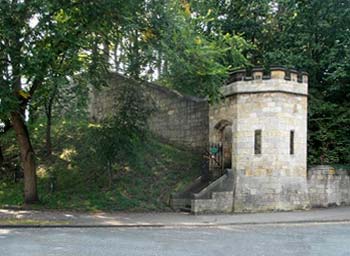Ecology of York's City Walls
York’s City Walls are some of the finest medieval defences in the country. Their ramparts are also a vital habitat for the city’s plants, animals and insects, including at risk species such as the bee orchid.
In the face of a climate emergency and a degrading ecosphere it's critically important that we:
- examine our maintenance strategies for The City Walls
- make sure everything we do is best practice for ecology and heritage conservation
Changes in York's City Walls ecology
Members of our Ancient Monuments Team summarised (in September 2024) the changing ecology of York's City Walls, describing how the ramparts have constantly evolved.
Read about:
- Varied appearance of ramparts over the years
- City walls and ramparts at Station Rise
- Ramparts and York’s character
- Health, social, economic and conservation considerations
- More sustainable management of York's ramparts
Varied appearance of ramparts over the years
The city ramparts have varied in appearance over the years, depending on the concerns of the time.
During periods of potential threat to the city, such as the Scottish wars of independence and the Civil War, the ditches and embankments were probably kept clear of vegetation, which might provide cover for besiegers, leaving them exposed to counterattack from the wall walk or the towers.
'Murage taxes' were levied for the building and maintenance of city defences. Another tax, tallage, a kind of land use or tenure tax, was charged on tenements owned by the king and provided an income for the upkeep of the defences.
Regular orders were given for the maintenance and clearing of these spaces, to ensure they were maintained, especially during periods of war. They were also a valuable resource for the city.
From the 14th century documents record the grazing rights, or ‘herbage’, for the whole circuit, including in more recent times the moats and ditches, were leased to tenants to provide income to the City.
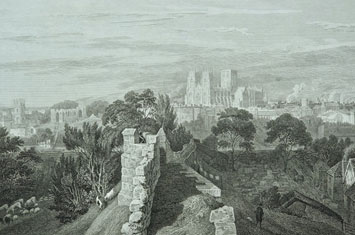
Source: J. Britton, 1836.
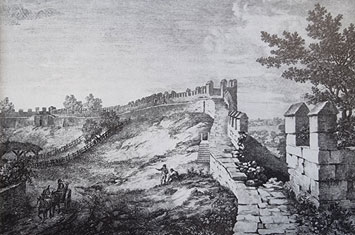
Source: J Halfpenny, 1807.
Pictorial evidence shows that the ramparts were, by the 19th century, dotted with shrubs and trees and were still being grazed by sheep and cows until the 20th century.
City walls and ramparts at Station Rise
The 13th century walls and ramparts (embankments) at Station Rise have seen some of the most dramatic changes visible anywhere on York’s walls.
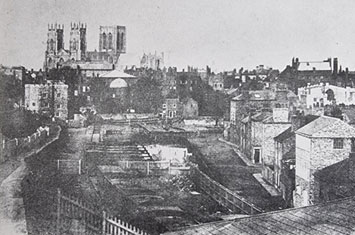
Source: W. Pumphrey, 4 Oct 1852 (Murray 1986, 32; Evelyn Collection)
Archways were knocked through between 1839 and 1847 to allow railway access into the city.
The site of the first phase York Walls in Bloom wildflower area was for part of the 19th century space occupied by railway sidings, as can be seen in one of the earliest photographs of York, by W. Pumphrey.
The present train station was built outside the city walls between 1871 and 1877, at which time the ramparts were reinstated and planted with shrubs and trees. Lendal Bridge, between Barker Tower and Lendal Tower, was built at this time to replace the Lendal ferry.
In 1876 Tower 18 was demolished to create a new road layout connecting the bridge and railway station, through two further breaches through the City walls.
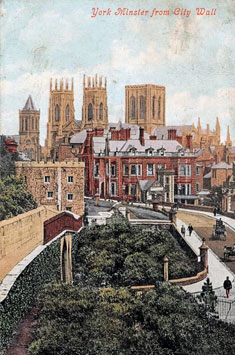
Source: J. Valentine. 1886. Souvenir Postcard no. 06236.
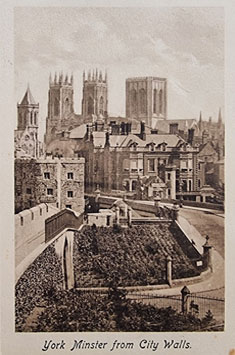
Source: Frith’s Series Postcard no. 18429a, c1885.
A series of postcard images shows the progression of the newly reinstated ramparts in this area from being thickly planted with shrubs in the 1880s, to the now-familiar formal beds and lawn from the mid-1930s.
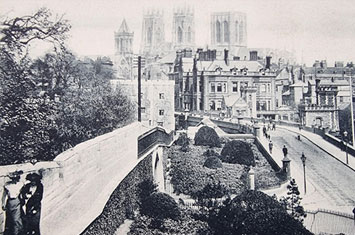
Source: W R & S Reliable Series, c1890s.
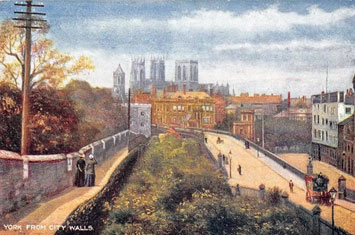
Source: Raphael Tuck and Sons, c1890, York from City Walls - Oilette no. 7698.
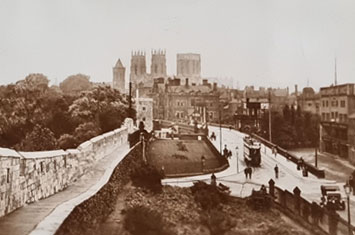
Source: Bridge House Real Photos Series, c1930s, S.10718.
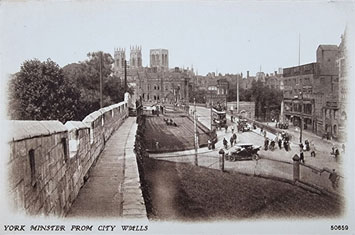
Source: Photochrom Co Ltd, c1935, London and Tunbridge Wells, edition no. 50659.
Ramparts and York’s character
The ramparts are a key element of York’s character and provide an important urban habitat of around six hectares of grassland and woodland, forming part of a network of local green corridors emanating from the city centre out to the surrounding countryside.
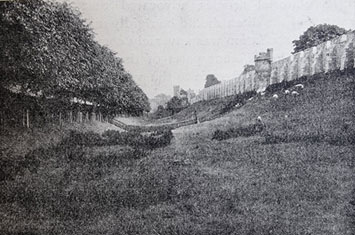
Source: Cooper 1904
The grasses and flowers on the ramparts provide a major source of nectar and pollen for insects in the city centre, which in turn provide part of the diet of Pipistrelle Bats and Swifts. Tall-herb vegetation (such as Cow Parsley) is likely to be an important source of chick-food for House Sparrows.
In recent years the steeper sections of the bank have been cut twice a year, and the flatter area between 6 and 8 times.
Health, social, economic and conservation considerations
It is increasingly recognised that green spaces, such as the ramparts of York's City Walls, are vital to the overall health of the city.
- Immersion in nature has proven health benefits, as well as adding social and economic value to local communities.
- Vegetation stores carbon, improves air quality, and helps mitigate the effects of urban warming, reducing the intensity of extreme heat and improving soil moisture retention.
Vegetation is also important for the conservation of the ramparts; roots help stabilise and regulate the moisture content in the soil, protecting the rampart, and The City Walls, from the effects of increasingly extreme heat and rain events caused by climate change.
Our management of The City Walls, including our approach to the ecology of the ramparts, aims to use current best conservation practice.
Always seeking ways to improve the conservation management of the monuments, we also aim to promote The City Walls to ensure their continued protection and that they enhance the city. The Buzz About York campaign gave us the opportunity to reconsider the management of the ramparts to make biodiversity a priority.
More sustainable management of York's ramparts
The seasonal bedding displays, and well-kept lawn will be familiar to most residents and visitors to the city; they have delighted visitors for decades with interesting and unique designs. However, the displays are not without their downsides. They're resource intensive in terms of water and carbon used in the growing, transporting, planting, watering, weeding and removing bedding plants, making them increasingly financially and environmentally unsustainable for the city.
We need to move towards a more sustainable management approach for York's ramparts, while maintaining the stunning foreground to the city vista from the walls that the Station Rise site has always provided.
The new management approach for the ramparts has required a significant amount of planning, patience, and the support of partners at York Cares and The Grand, York, to put into action.
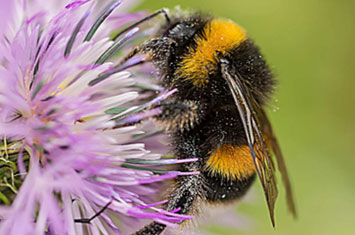
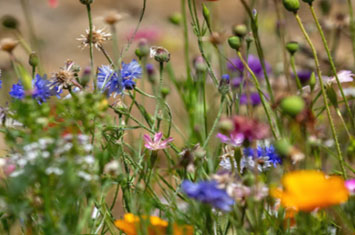
Inspired by similar projects, such as Moat in Bloom at the Tower of London, we believe that carefully managed wildflower planting offers the right balance of aesthetics, and better sustainability wildlife habitat.
The preparation for the York Walls in Bloom 2025 at the Station Rise site has required a staged approach over the course of spring and summer 2024:
- plants were allowed to grow for several months to allow a baseline ecological study to ensure that any intervention didn’t endanger existing plants there; the results, showed that the sites have low habitat and botanical scores, being dominated by grasses, and therefore has poor value for wildlife
- an archaeological assessment was undertaken to confirm that the preparation of the site wouldn’t cause any harm to the scheduled ancient monument; this showed that the topsoil is more than 200mm deep across the site, so the proposal is unlikely to disturb anything of archaeological significance.
An archaeological watching brief will also be maintained during any preparation.
With the appropriate investigations completed, we were then able to apply to Historic England for scheduled monument consent to begin preparing the ground and sowing a mix of wildflower seeds in Autumn 2024, to deliver a colourful wildflower display worthy of this iconic viewpoint of the city in the spring and summer of 2025.
The Station Rise area will be very carefully managed to ensure a balance between the long-term habitat and botanical quality, and its visual appeal as a foreground to this iconic view of the city from York’s city walls.



